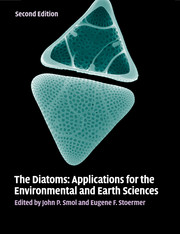Book contents
- Frontmatter
- Contents
- List of contributors
- Preface
- Part I Introduction
- Part II Diatoms as indicators of environmental change in flowing waters and lakes
- Part III Diatoms as indicators in Arctic, Antarctic, and alpine lacustrine environments
- 12 Diatoms as indicators of environmental change in subarctic and alpine regions
- 13 Freshwater diatoms as indicators of environmental change in the High Arctic
- 14 Diatoms as indicators of environmental change in Antarctic and subantarctic freshwaters
- Part IV Diatoms as indicators in marine and estuarine environments
- Part V Other applications
- Part VI Conclusions
- Glossary, acronyms, and abbreviations
- Index
- References
12 - Diatoms as indicators of environmental change in subarctic and alpine regions
from Part III - Diatoms as indicators in Arctic, Antarctic, and alpine lacustrine environments
Published online by Cambridge University Press: 05 June 2012
- Frontmatter
- Contents
- List of contributors
- Preface
- Part I Introduction
- Part II Diatoms as indicators of environmental change in flowing waters and lakes
- Part III Diatoms as indicators in Arctic, Antarctic, and alpine lacustrine environments
- 12 Diatoms as indicators of environmental change in subarctic and alpine regions
- 13 Freshwater diatoms as indicators of environmental change in the High Arctic
- 14 Diatoms as indicators of environmental change in Antarctic and subantarctic freshwaters
- Part IV Diatoms as indicators in marine and estuarine environments
- Part V Other applications
- Part VI Conclusions
- Glossary, acronyms, and abbreviations
- Index
- References
Summary
Introduction
Subarctic and mountain regions are characterized by strong gradients that make their terrestrial and aquatic ecosystems very sensitive to environmental change. The terrestrial Arctic can be delimited by the northern tree line, the 10 °C July isotherm, or the southern extent of discontinuous permafrost which, in the eastern Canadian Arctic for example, currently extends to the southern end of Hudson Bay. In this chapter, we focus on the subarctic region, which, depending on local climates, roughly falls between 50° N and 70° N latitude and includes the transition from boreal forest (taiga) in the south to tundra landscapes in the north, whereas the chapter by Douglas and Smol (this volume) discusses diatom-based studies from the High Arctic. In mountain regions the same steep climatic and environmental gradients are present but over much shorter distances, with the timber line also representing the most prominent ecotone. It is characterized by the transition from closed forest to the most advanced solitary trees (i.e. timber line), to single tree islands (i.e. tree line), and eventually to open, unforested vegetation. This biological boundary can vary in width from tens of meters in mountain regions to many kilometers in the Subarctic. In northern Europe it is formed by deciduous trees such as Betula, Alnus, and Populus, whereas coniferous trees (e.g. Pinus, Picea, Larix, Juniperus) form the tree line in the European Alps, northern North America, and Eurasia.
- Type
- Chapter
- Information
- The DiatomsApplications for the Environmental and Earth Sciences, pp. 231 - 248Publisher: Cambridge University PressPrint publication year: 2010
References
- 25
- Cited by



